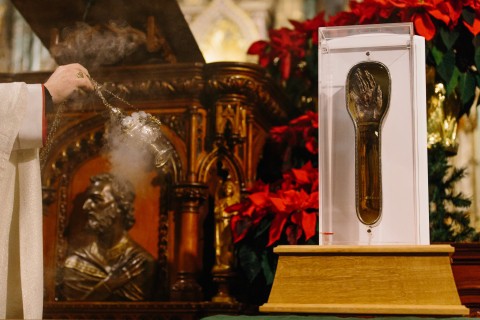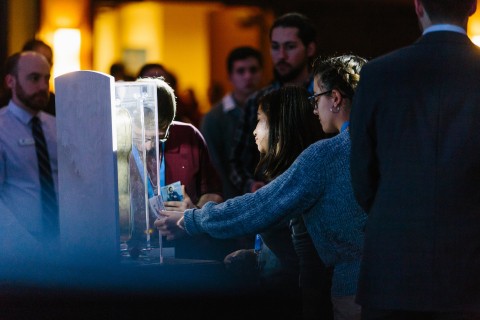It’s not every day that a religious relic comes to Saskatoon — let alone the severed forearm and hand of one of the Catholic church’s most important missionary figures. In fact, according to Angèle Regnier, this is likely the first time the arm has come to Canada.

The desiccated but incorrupt hand of St. Francis Xavier in its protective case.
Regnier is a University of Saskatchewan alumna and co-founder of Catholic Christian Outreach, one of three bodies that organized to bring St. Francis Xavier’s arm to Canada. When the relic isn’t on pilgrimage, its permanent home is the Church of the Gesù in Rome.
Francis Xavier was born in 1506 in the now defunct Kingdom of Navarre, which is part of modern-day Spain. He is considered the most important Catholic missionary after St. Paul, and it’s estimated that he converted anywhere from 30,000 to 100,000 people to the Christian faith.
Regnier explains that the relic rarely travels — its last visit was to Australia in 2012, and before that, it made a trip to the United States in 1950. She hopes that those who visit the relic will witness the three graces associated with its pilgrimage, linked to graces Francis Xavier demonstrated in his lifetime.
“We anticipate people having a deeper conversion of heart to the Lord Jesus Christ [and] having a greater abandonment to God’s will … and what he may be calling people to do in life,” Regnier said. “And then, the third [grace] is healing, because Francis Xavier healed many people and even raised people from the dead.”
Courtnay Konshuh, term professor in history at St. Thomas More College, notes that this relic is significant because of its history and completeness.

The St. Francis Xavier relic is making what is likely its first appearance ever in Canada on a cross-country tour.
“What’s really cool is that we know for sure that this is [Francis Xavier],” Konshuh said. “That can be documented… The arm is super complete, and that’s pretty unlikely, actually… That it’s his blessing hand is really important if you’re Christian, because it’s the hand [with] which he touched all the people that confers blessings.”
Regnier explains that, after Francis Xavier’s death in 1552, he was buried once off the coast of China and again in Malaysia, for a total period of almost two years, before being transferred to the Basilica of Bom Jesus in Goa, India — one of his key missionary sites. Each time the body was exhumed, no natural decomposition had taken place, making Francis Xavier what is called an incorrupt saint.
“We believe in the resurrection of the body and life everlasting — that someday our bodies will be resurrected for eternity,” Regnier said. “And so, these incorrupt saints are like a sneak preview of what is to come — that we are to live forever in heaven, even in our bodies.”
Konshuh notes that there are numerous documented cases of incorruption, and that it is a significant indicator that someone is a saint.
“The key is that [the body] doesn’t liquify… So, you can do it artificially — if you mummify a body, then it won’t liquify, it’ll dry out,” Konshuh said. “But, the key with a sign of a person being a saint, and this is since the fourth century, … is God doesn’t allow their body to decompose in the normal way, and they dry out.”
Regarding incorruption and whether or not it actually takes place, Konshuh explains that she believes such a phenomenon is far more likely than the numerous miracles associated with a saint.
“In general, I would say [saint’s stories are] mostly propaganda. Most saints’ lives were written by the monastery that acquired their bones, as essentially a tourist and money-generating trap. There are heaps of stories of miracles that happen after the saint is kept there, … like a thief comes to steal something from the church, and then, they’re just stuck in the earth, and it’s the saint that holds them fast until people come and find them,” Konshuh said.
In 1622, Jesuits in Rome requested to have St. Francis Xavier’s right arm brought to them, as he is one of the founding members of the Jesuit church. According to Konshuh, the origins of most relics are not so easy to trace, and many cannot be associated with the complete body of a saint. In fact, relics often forcefully changed hands and were sometimes collected by scavengers.
“Basically, you scavenge [relics]. If [a saint] dies near you, then you take them… But, you can also buy relics, and the best way to get them, really, is to steal them. So, there’s lots of cases in the medieval period of important rulers stealing saints’ relics from a different church and bringing them to the new church that they wanted to promote,” Konshuh said.
Although St. Francis Xavier’s body is mostly complete, he has not been immune to theft. Indeed, during an early exhibition of the body, a Portuguese woman reportedly bit off one of his toes, hoping to set up a rival pilgrimage attraction — a situation that Konshuh says was not uncommon.
“There are other records of people doing stuff like that,” Konshuh said. “Sometimes, they would swallow it, because then, it would be within them, and they felt that that brought them really close [to the saint].”
Although the arm is encased in glass — leaving no opening for crafty scavengers — anyone can visit the relic on its cross-Canada tour. St. Francis Xavier’s arm will be displayed in Saskatoon on Jan. 18, from 12 p.m. to 10 p.m., for public veneration at the Holy Family Cathedral.
A guide book about the relic and what to expect as a visitor is available at cco.ca/relic.
—
Jessica Klaassen-Wright / Editor-in-Chief
Photos: Catholic Christian Outreach / Supplied